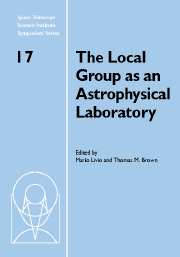 The Local Group as an Astrophysical Laboratory
The Local Group as an Astrophysical Laboratory Book contents
- Frontmatter
- Contents
- Participants
- Preface
- History of the Local Group
- Primordial nucleosynthesis
- Galactic structure
- The Large Magellanic Cloud: Structure and kinematics
- The Local Group as an astrophysical laboratory for massive star feedback
- Hot gas in the Local Group and low-redshift intergalactic medium
- Stages of satellite accretion
- The star formation history in the Andromeda halo
- Bulge populations in the Local Group
- The Local Group as a laboratory for the chemical evolution of galaxies
- Massive stars in the Local Group: Star formation and stellar evolution
- Massive Young Clusters in the Local Group
- Magellanic Cloud planetary nebulae as probes of stellar evolution and populations
- The old globular clusters: Or, life among the ruins
- Chemical evolution models of Local Group galaxies
Magellanic Cloud planetary nebulae as probes of stellar evolution and populations
Published online by Cambridge University Press: 12 May 2010
- Frontmatter
- Contents
- Participants
- Preface
- History of the Local Group
- Primordial nucleosynthesis
- Galactic structure
- The Large Magellanic Cloud: Structure and kinematics
- The Local Group as an astrophysical laboratory for massive star feedback
- Hot gas in the Local Group and low-redshift intergalactic medium
- Stages of satellite accretion
- The star formation history in the Andromeda halo
- Bulge populations in the Local Group
- The Local Group as a laboratory for the chemical evolution of galaxies
- Massive stars in the Local Group: Star formation and stellar evolution
- Massive Young Clusters in the Local Group
- Magellanic Cloud planetary nebulae as probes of stellar evolution and populations
- The old globular clusters: Or, life among the ruins
- Chemical evolution models of Local Group galaxies
Summary
Planetary Nebulae (PNs) in the Magellanic Clouds offer the unique opportunity to study both the population and evolution of low- and intermediate-mass stars, in an environment that is free of the distance scale bias and the differential reddening that hinder the observations of the Galactic sample. The study of LMC and SMC PNs also offers the direct comparison of stellar populations with different metallicity. The relative proximity of the Magellanic Clouds allows detailed spectroscopic analysis of the PNs therein, while the Hubble Space Telescope (HST) is necessary to obtain their spatially-resolved images. In this paper we discuss the history and evolution of this relatively recent branch of stellar astrophysics by reviewing the pioneering studies, and the most recent ground- and space-based achievements. In particular, we present the results from our recent HST surveys, including the metallicity dependence of PN identification (and, ultimately, the metallicity dependence of PN counts in galaxies); the morphological analysis of Magellanic PNs, and the correlations between morphology and other nebular properties; the relations between morphology and progenitor mass and age; and the direct analysis of Magellanic central stars and their importance to stellar evolution. Our morphological results are broadly consistent with the predictions of stellar evolution if the progenitors of asymmetric PNs have on average larger masses than the progenitors of symmetric PNs, without any assumption or relation to binarity of the stellar progenitors.
Introduction
Planetary Nebulae (PNs) are the gaseous relics of the envelopes ejected by low- and intermediate-mass stars (1 < M < 8 M⊙) at the tip of the asymptotic giant branch (AGB), thus they are important probes of stellar evolution, stellar populations, and cosmic recycling.
- Type
- Chapter
- Information
- The Local Group as an Astrophysical LaboratoryProceedings of the Space Telescope Science Institute Symposium, held in Baltimore, Maryland May 5–8, 2003, pp. 196 - 207Publisher: Cambridge University PressPrint publication year: 2006


